I began climbing in the mid-1980s at a small crag situated on the Erie Canal in Little Falls, New York. At the time, 5.12 onsights were mentioned in national climbing media, and 5.13s were akin to watching Alex Honnold free solo El Cap. For thirty years, I carried the mentality that 5.13 was beyond my reach and remained happy on my 5.10-5.11 plateau.
When I turned 50, a very basic bouldering gym opened in Central New York, not far from my home. Here, I trained and began climbing with a stronger crew. I changed my focus away from trad to sport, away from onsighting to redpointing, and began seeing improvements. Suddenly, I was climbing 5.12 regularly, and climbing 5.13 began to feel like a real possibility.
Today, grades have been pushed to 5.15d. Climbing 5.13 is no longer a big deal for many in the climbing world. But it is to me.
At 51, I finally managed my first 5.13a, a beast of a climb aptly named Eye of Sauron in the Adirondack Mountains. My second 5.13, Zah Dude, required many days of effort. Outside of my stomping ground, however, climbing 5.13 seemed elusive, if not impossible.
So I decided to set a challenge for myself that I called “Project Thirteen.” I would climb thirteen 5.13 routes, each one in a different country. This would combine everything I loved about climbing, performance, and travel into one birthday-challenge-style feat that would give me a reason to stay motivated and psyched.
Project Thirteen ended up taking five years to complete, in part because of the pandemic, which made travel difficult. But the amount of time it took is hardly the point. Through this process of climbing 5.13 around the world, I discovered some of the best routes I’ve ever done, and most rewarding experiences of my life. There was an epic involving monkeys in Colombia. The time I crawled on my hands and knees though a climber’s toilet to save my partner’s lunch. The time I forgot my left shoe and had to hike two extra hours. Traveling on a 1966 Mercedes bus through Patagonia. The Patagonian wind. Walking through somebody’s living room and kitchen on the approach to a crag. Floating in an underground fresh-water lake in Laos. And all of the partners who supported me and friends I made along the way.
Through this process, I discovered some of the best routes I’ve ever done, and most rewarding experiences of my life.
Over my lifetime, climbing has taken me to 34 countries. The privilege of this travel has not only helped me become a better climber, but it has also helped me shed my ignorance and wake my curiosity to all the different ways of being a person in this world. Ultimately, climbing 5.13 is not nearly as important as letting climbing be your excuse to explore, learn, and grow.
I wanted to share my Project Thirteen tick list with the hope it inspires others out there who aren’t pro climbers, who may be in their mid-50s, to dream big and come up with their own project that inspires them to do what they never thought they could.
1. Zah Dude (5.13b)

Mikayla Tougas on the second ascent of Zah Dude. Photo: Jim Lawyer
My first hard route was on my home turf, at a remote crag in the heart of the Adirondack Mountains in New York.
On the send, I skipped the topmost bolt and screamed my way to the chains. This route, my second 5.13 ever and a first ascent as well, helped me discover the “beast within”—that little bit of try-hard that you need to send something at your limit.
2. Boom Boom (5.13a)

Caption: Val Shao on her redpoint of Boom Boom. Photo: Jim Lawyer
After Zah Dude, I found it difficult to climb hard beyond my home area. It wasn’t until 2018 in Kalymnos that I discovered Boom Boom, an intricate face climb with a long, tricky crux. While lowering, I rehearsed the difficult moves, pulled the rope, and fired it next go. The beta suited me and it just clicked.
Lesson: when climbing abroad, chose projects that suit your strengths, and know when to move on if it doesn’t feel right.
3. Orion (5.13a)
I had heard good things about the climbing in Chicamocha Canyon, Colombia, and took special interest in a route called Orion based on Ben Ditto’s photo of Katie Lambert on the route. Upon arriving, the route looked even better because it was free of beehives that are otherwise dotting the cliff. I didn’t get stung, but I did send this brilliant rock climb on my second day trying it.
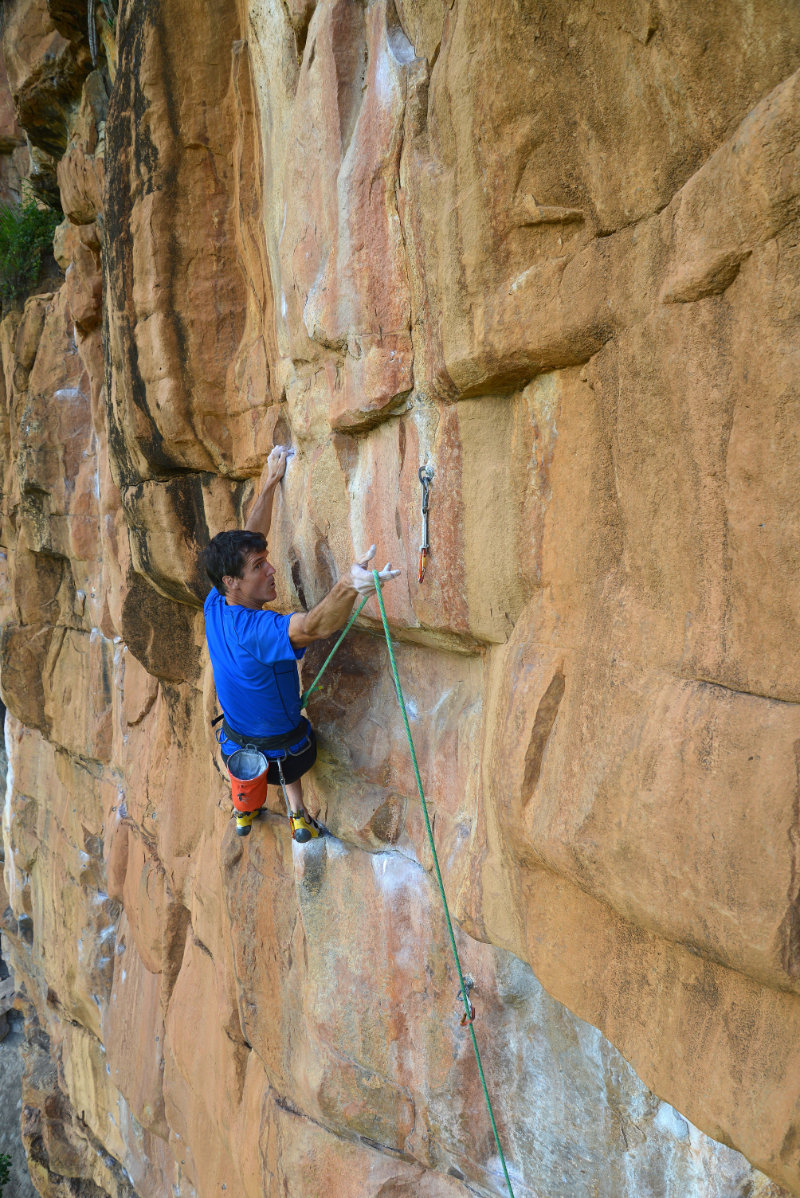
Caption: Jim Lawyer on his redpoint, leaning back to clip the skipped bolt. Photo: Luis Romero
Climbing 5.13 is no longer a big deal for many in the climbing world. But it is to me.
4. Camino del Chino (5.13b)
Tucked in a deep, narrow canyon above a 4WD track is a stunning, gently-overhanging golden streak of impeccable stone. While tricked-out buggies drove past blasting música norteño (Mexican polka) at full volume, I watched a strong group work Camino del Chino. I felt intimidated, so it wasn’t until several days later when nobody was around that I summoned the nerve to try it. On my first go I fell just before the anchor having missed a crucial knee-bar. A few days later, I gave it another attempt, milked the knee-bar, and sent.
Lesson: don’t let other people’s struggles psych you out.
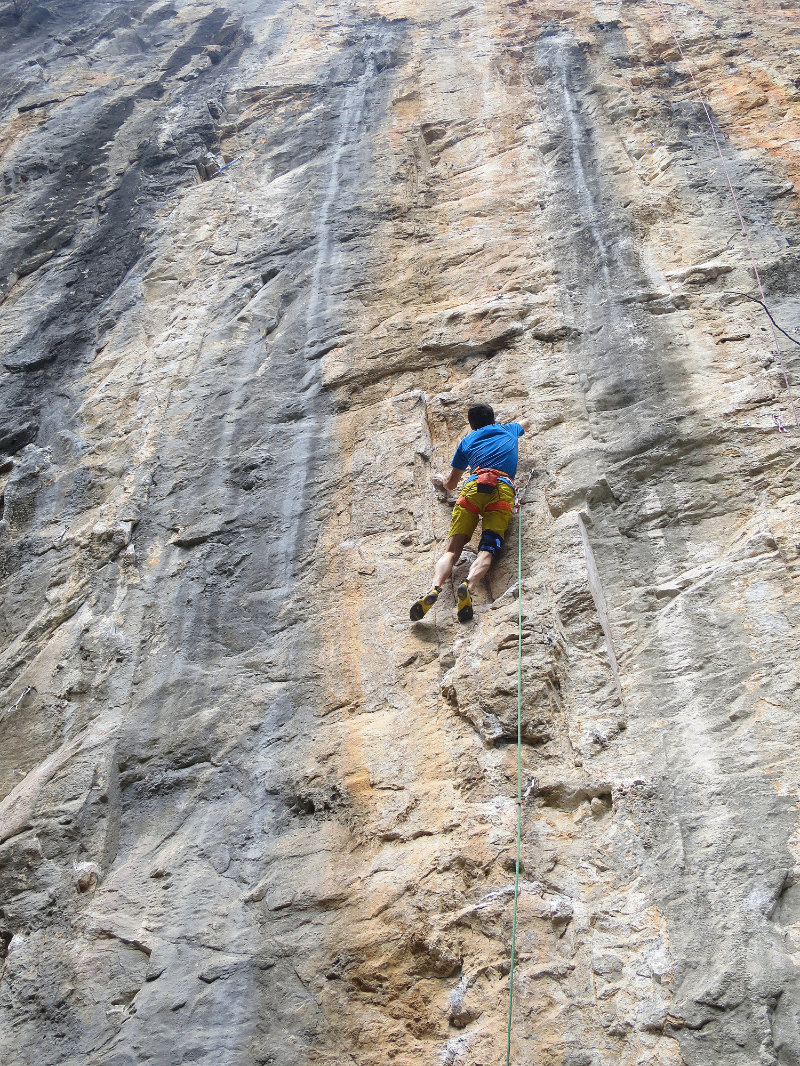
An impeccable line of golden crimps on Camino del Chino. Photo: Val Shao
5. El Remanso de las Mulas (5.13a)
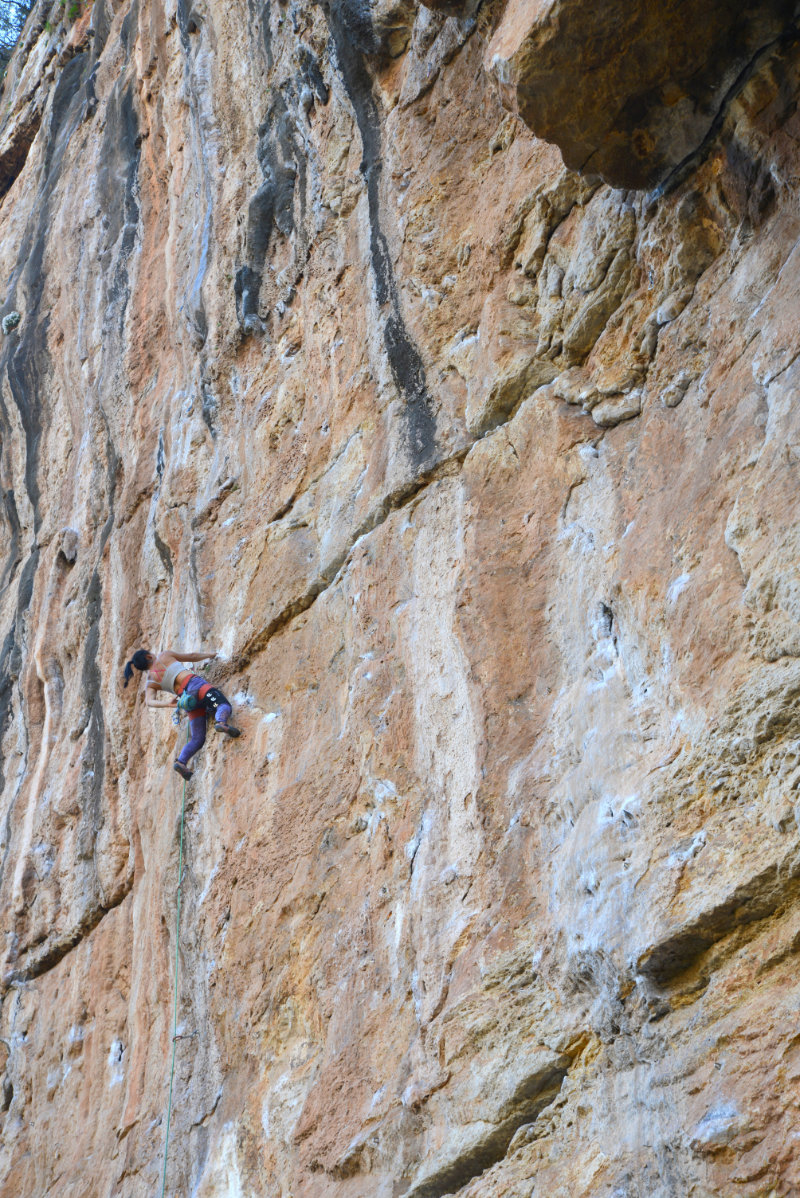
Val Shao on her redpoint. Photo: Jim Lawyer
Early during my trip, I tried El Remanso de las Mulas and got shut down about four bolts up at a puzzling blank section. Aiding through this, I rested on every bolt and was left with the impression that this route was out of my league. Later in the trip after other successes, I returned for a rematch, toproping to unlock the mysterious blank section and fine-tuning my movements on the pumpy, tufa-filled upper sections. As I learned, first impressions are unreliable and I sent next go.
Lesson: don’t be afraid to top-rope hard sections to refine your sequence.
6. Coeur De Lion (5.13a)
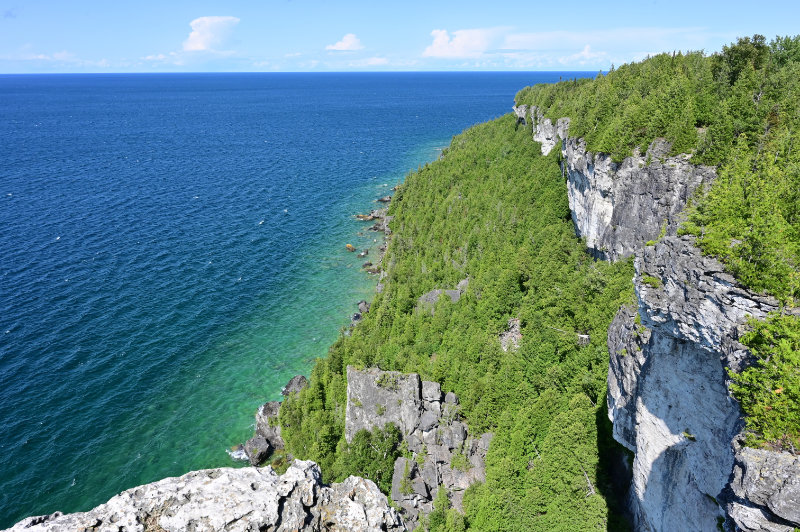
The beautiful cliffs of Lions Head on the Georgian Bay. Photo: Jim Lawyer
Lions Head, a picturesque, limestone sport climbing area on the shores of Georgian Bay, is an intimidating place with few easy grades. I chose to try Coeur De Lion, Ontario’s first 5.13. It’s a line of sculpted pockets on a gently overhanging wall. I was told this was a “kid’s route” because the pockets are well suited for small fingers. I can say it’s also a tall-person’s route, as I was able to avoid the smallest of them. After some toprope rehearsal, I got this on my first lead attempt.
Lesson: find your own beta.
7. Les Yeux qui piquent (5.13a)

Jim Lawyer on the crux during his redpoint. Photo: Manu Fonbeurre
Deep in the twisty canyon of La Buitrera is the route Les Yeux qui piquent, a 35-meter line of pockets with a blank crux at the top. A devious and sequential series of crimps led past this to a large hole, and from there it’s an endurance run to the anchor. I used the projecting technique learned earlier—exhaustively practice the beta on toprope, rest a day, then send the next day giving me the freedom to really enjoy the windy Patagonian Steppe without any redpoint pressure.
8. Mejor Meao que mal Acompañao (5.13a)
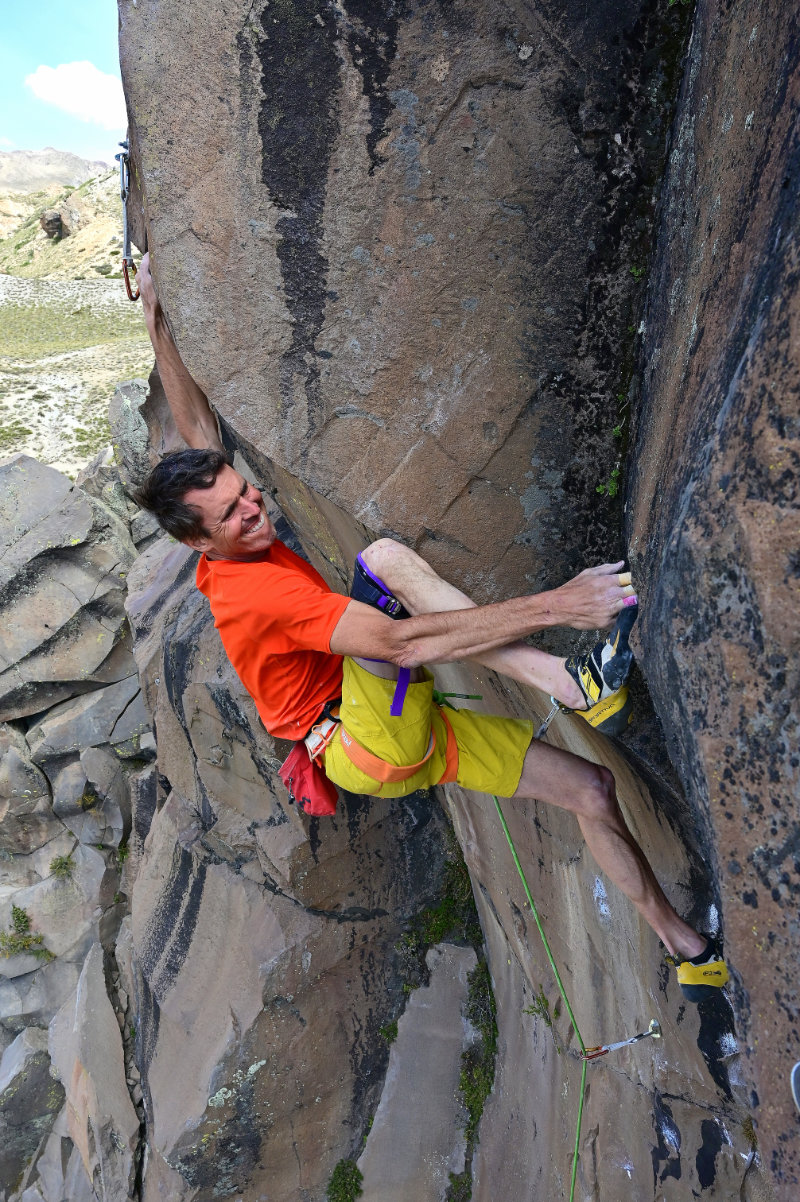
Jim nabbing the jug off the Jaws pocket on his send. Photo: Manu Fonbeurre
The basalt in this high-mountain valley in Chile produces frictionless panels and crazy geometric shapes—a difficult style to learn while traveling.
Mejor Meao que mal Acompañao crests in a wave-like finish with a perfect, toothy “Jaws” pocket crux. What a line! While working the route, I tore a huge flapper in my forefinger but with some clever gluing, I was able to send a few days later.
Lesson: learn proper skin care so a flapper doesn’t end your trip.
9. Pole Dancer (5.13a)
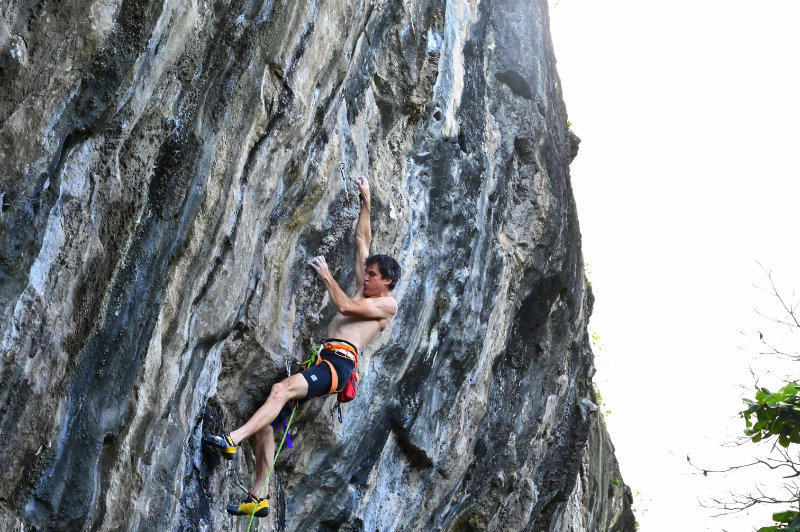
Jim enjoying the smarmy condies. Photo: Lucie Wellner
Hot and humid Cayman Brac has many great limestone crags filled with tufas, pockets, and edges that are often dripping and smarmy. These conditions stymied my initial attempts at Pole Dancer, but a lucky wind helped dry out the route somewhat. I stick-clipped my way up, removed the cobwebs and grunge, dried the holds with a towel and chalk sock, rehearsed the moves, and sent an hour later. Just in time, too. When I lowered, the holds had already begun to seep.
10. Change of Plans Direktissima (5.13a)
The Karst towers of Thakhek sport many tufas and plenty of easy grades. My early attempts on some of the harder routes in the area were thwarted by show-stopper moves. As I’ve learned, I kept searching and eventually found Change of Plans Direktissima, which proved to be more my style. The route is a gently overhanging face with three cruxes, each containing powerful moves on crimps. We spent a rest day in a cave, floating in an underground lake, enjoying nature’s air conditioning and avoiding the scorching sun. Returning fresh, I sent the route next go.
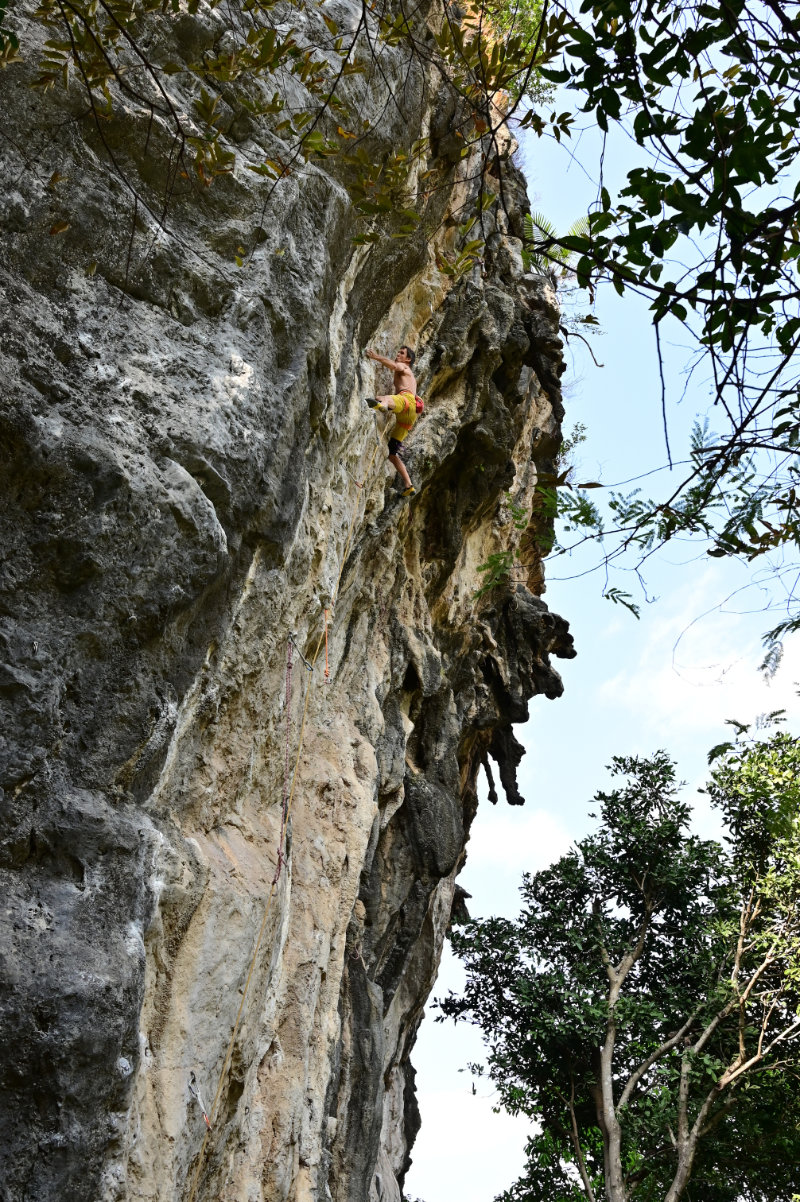
Jim on the send. Photo: Kyle Groening
11. Kura (5.13a)
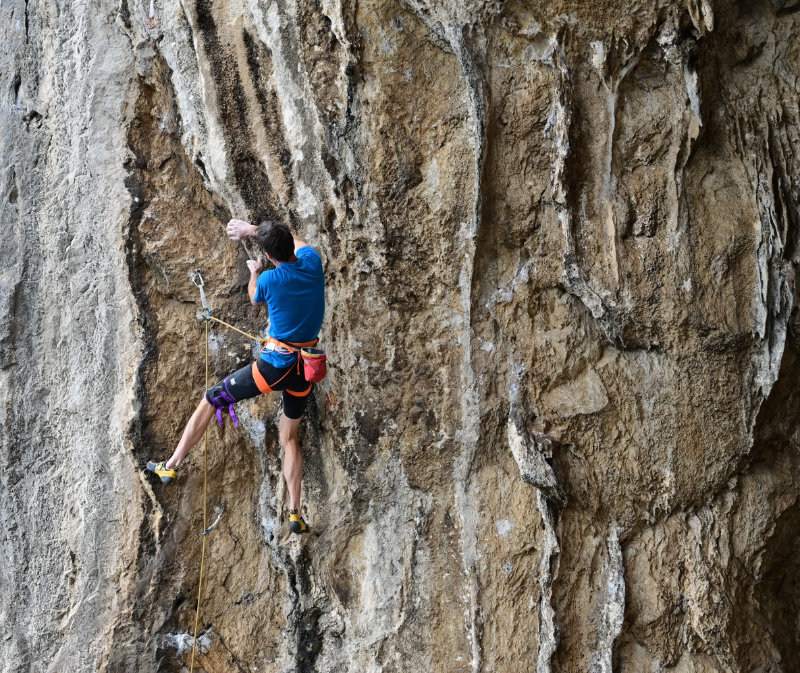
Riding tufas in Italy. Photo: Lucie Wellner.
Costiera is an isolated crag that sits above the sea on the outside face of a natural tunnel near Trieste, Italy. Kura is an enduro route with no great rests, taking a steep orange wall with some tufa ribs down low, and an overhanging face of grey limestone. After one session figuring out and rehearsing beta, I stripped the route and waited out several days of rain, uncertain if I’d have the opportunity to try again. On our last day in Italy, I returned to Costiera, warmed up, hung the draws, and I sent the route first go.
12. Yogi Line (13a)
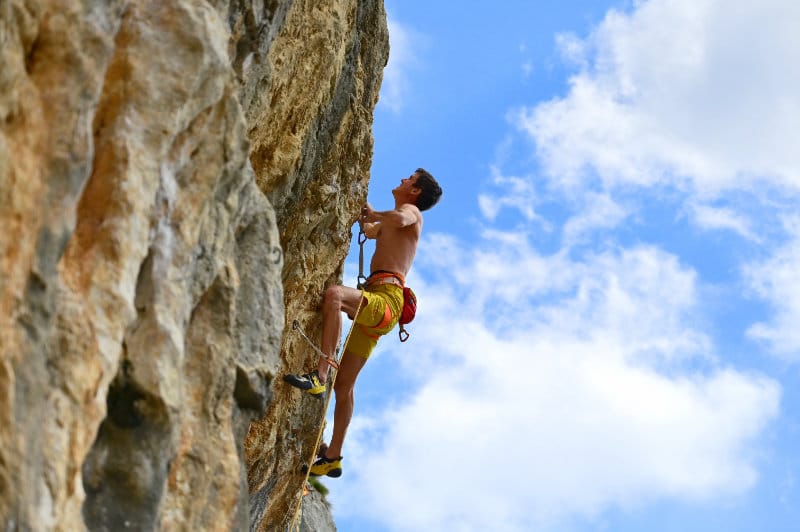
Jim just after the crux crimps on his send. Photo: Danny Mindham.
Yogi Line ascends a vertical wall to a crux bulge with heinous crimps. At first I could not crack this bulge. I had to really fine-tune the beta to get the handholds exactly right, especially the thumbs, the subtle pinches, and feet sequences. On my second day, I surprised myself with a “ghost send,” a send that sneaks up on you. I got the thumbs and pinches exactly right, as well as the critical toe-dig-body-twist move to grab the sidepull after the crux.
13. Le Privilège du Serpent (5.13a)
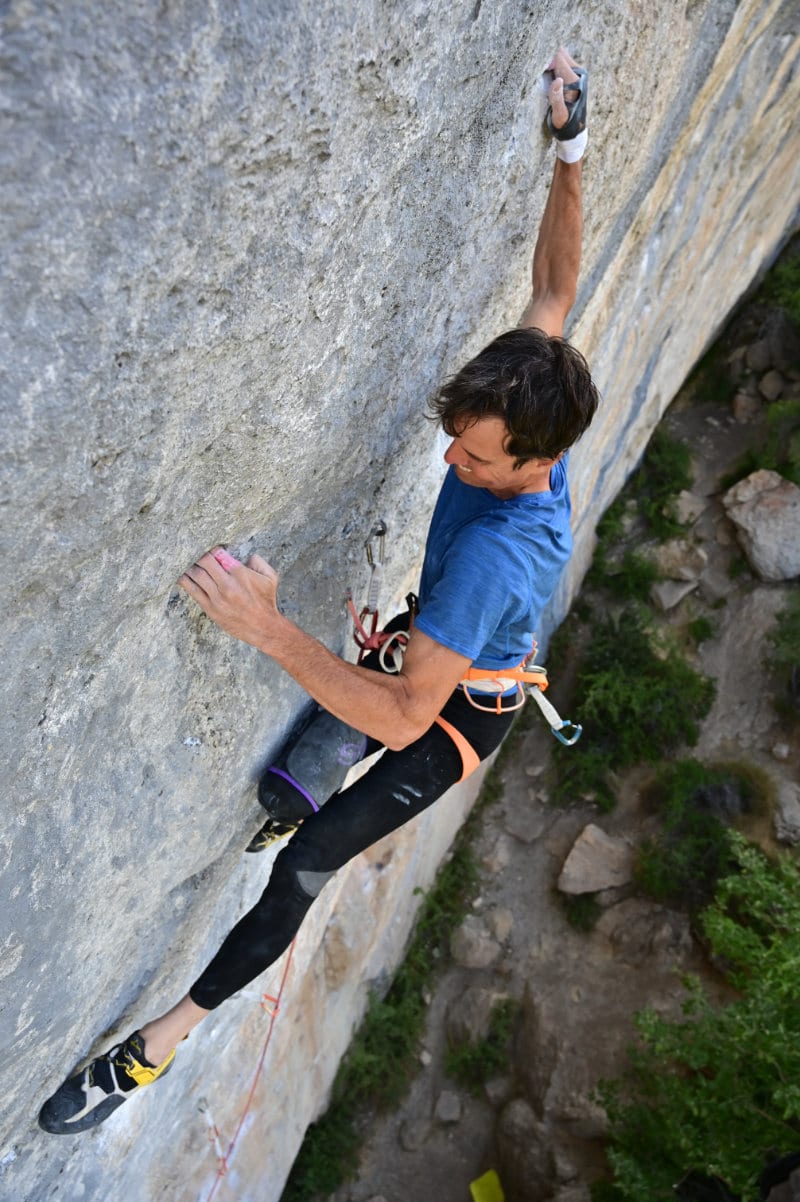
Perfect rock does exist… Photo: Manu Fonbeurre.
On my first day in Céüse, I hung draws on Le Privilège du Serpent, which has a four-hour window of morning shade. I could easily do all the moves, but linking them was going to be a challenge. I fell before the real crux of the route, pumped out of my mind. After a couple days of rest, I tried again and fell at the crux. “Still a long way off,” I thought. On my third attempt I regained my high point, and made a long move to a slopey pocket. I skipped a clip and screamed my way through several more long pocket moves, then a final dyno to a jug before the anchor. The thirteenth route was one of the hardest, but also one of the most satisfying.

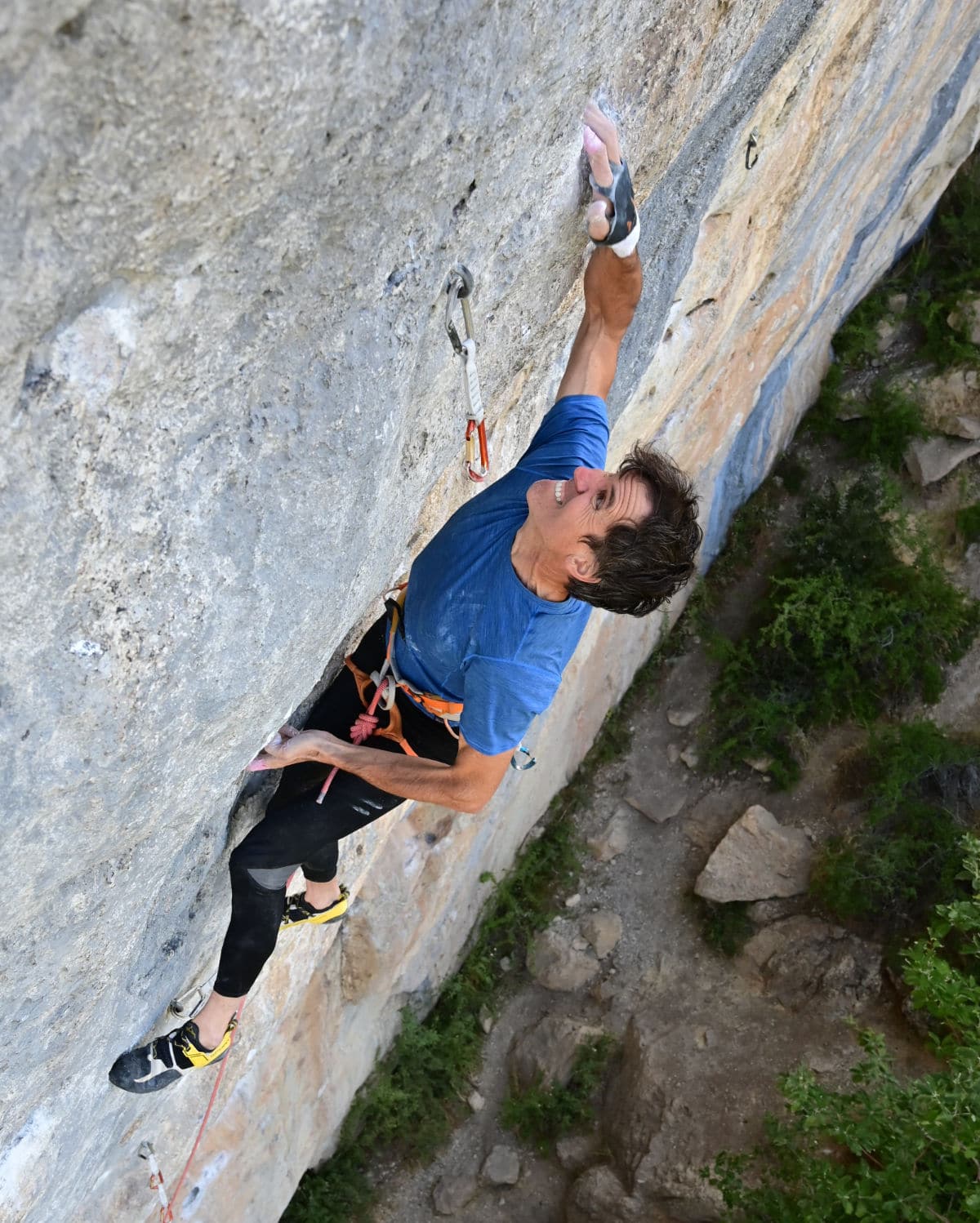
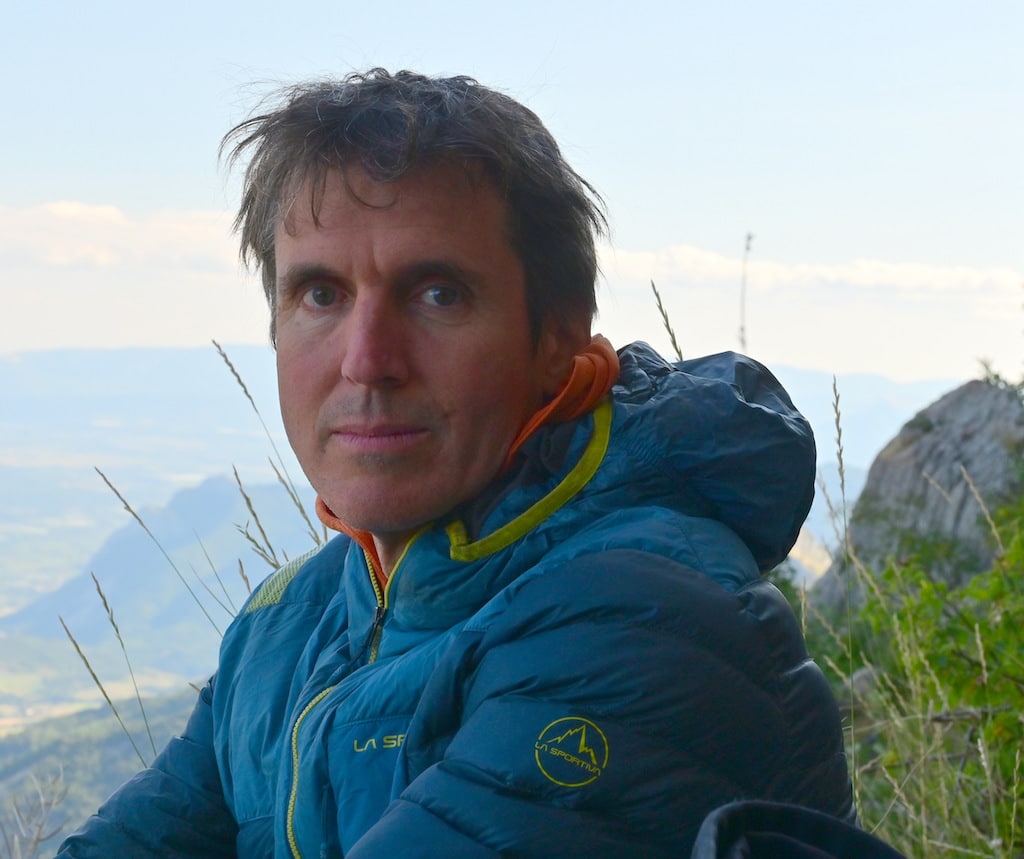

i thought you always climbed 13 jim! the photos were beautiful. miss the golden oldies trips at josh, including lucie’s cooking and art work. i just restarted climbing, lo level and infrequent, couple years ago. still annual canoe trips to arctic, and ski/hike at home. hope to see you and lucie sometime, somewhere.
Hi Bev!!! How’s Whitey? I miss climbing with you! I remember that trip to the City of Rocks so fondly…so much climbing. You guys still in Kelly?
My life goal is to climb a 5.13. I’ve climbed about 15 5.12’s (only up to 12b though), and I’m 61, so fingers crossed. Fun read, thanks for sharing!